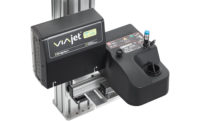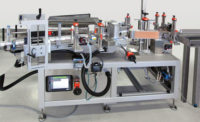Machinery Technology: Cartoning
Marking & Coding Product Features and Checklist
The essentials to delivering coding, marking and labeling made easy.






In today´s increasingly competitive market, manufacturers need more than quality printers. Top product identification solution providers go beyond this and offer a variety of strategic consultative services, proactively working with customers large and small to streamline coding and labeling operations and enhance operational efficiencies. Identifying a coding/labeling supplier who can combine quality technology with expert operational support allows manufacturers to maintain focus on their core business without the need to spend additional time and resources on supporting coding and labeling equipment.
To find such a strategic partner, make sure the supplier’s systems and services stand out by meeting the reliability and efficiency standards outlined in the checklist below.
Reliability: Print, Systems and Processes
Top suppliers will provide comprehensive expert insights into how to obtain reliable print, identify reliable systems and design reliable processes.
Reliable Print — Accuracy
Mismarked and mislabeled products create big hits to the bottom line. Here are several factors to consider when trying to reduce coding, marking and labeling mistakes:
- Technology Selection: Choose a supplier with a comprehensive product offering and expertise in all areas of packaging. By offering solutions that include inkjet coding, labeling, thermal transfer printing and laser coding, you can receive objective advice on the technology best suited to your unique situation. Packaging design and material, code contrast requirements, message content, labor skill level, application throughput and cost requirements should all be considered when comparing and selecting the best option.
- Ink, Label, Ribbon Match: Expertise in a wide variety of inks, label materials and ribbon formulations will allow suppliers to consider the application criteria — which can have a significant impact on these selections — to help you identify the best method for achieving durable, lasting print on your substrate.
- Material Handling: Perhaps the most often-overlooked aspect of print accuracy is material handling. Consistent presentation of your product to your new print station is critical to long-term success and optimized production throughput. While the coder or labeler should be able to accommodate some variation, your supplier should guide you to a technology that best suits your environment. The solution should also offer seamless integration into your line controls, which will allow you to manage the line or suspect product proactively and without intervention.
- Verification and Validation: A quality supplier versed in the latest verification and validation technologies can ensure that a mark has been successfully applied, matches the mark you requested and is completely readable — taking you a step closer to guaranteed compliance.
Reliable Systems — Durability
Pay particular attention to the printhead when comparing systems, because this is the element of the printer that commonly suffers the most wear and tear. Be sure the printhead of any system you are considering features:
- Stainless Steel Construction: Printheads constructed of stainless steel materials can last up to 30 times longer than those made out of plastic materials.
- Sealed Design: Exposed wires and designs that require regular printhead adjustments make printheads less durable and reliable, and they require a high degree of intervention from your skilled labor pool.
- Automated Maintenance: Inkjet printheads that offer automatic cleaning capabilities allow for less human handling of the equipment, minimizing downtime and possible equipment damage.
- Shock Resistance: When product identification systems inevitably come into contact with product on active production lines, poorly designed printheads encounter major durability issues. Well-constructed printheads are strong enough to withstand these types of impacts. Some inkjet coders also feature material handling mechanisms that gently guide the printhead away from the product to minimize the impact on the printhead.
Reliable Processes
Be sure any supplier you are considering will conduct a complete site (or sites) audit to pinpoint areas where slight changes in coding operations can provide valuable benefits in terms of identifying and eliminating bottlenecks and workarounds. Audits include expert analysis of:
- Productivity and condition of existing equipment: Is your equipment performing to its fullest capacity? Is it a proper match for your application? Are there any modifications or maintenance actions that can enhance productivity?
- Proficiency of machine operators: Are there system features that are not being used that could improve efficiencies? Could your production team benefit from higher-level training? Are there deficiencies in your current solution that make it difficult for operators to perform daily tasks?
Efficiency: Products and Services
To ensure your team is not weighed down with unnecessary system upkeep requirements, find a product identification solution that can deliver maximum uptime by comparing:
- Length of time between consumable replacement: For inkjet coders, determine how long a printer can run after the ink bottle or cartridge has run out of fluids. Does the system provide enough advanced warning to allow for fluids to be replenished at ideal production times like before and after shift changes? Can the fluids be replaced while the system is actively coding?
For thermal transfer printers, consider the maximum size of the ribbon roll for your chosen ribbon type. To maximize ribbon usage, look for thermal transfer printers that offer ribbon saving features that utilize as much ribbon surface area as possible.
- Streamlined consumable replenishment: Consumable replenishment can be made easier and less time consuming.
For inkjet coders, look for mess-free refill options like needle and septum systems that prevent leakage when swapping fluid bottles. Look for systems that provide one-touch fluid refill options, as well as specifically designed ink and solvent bottles, to prevent the wrong fluids from going into the wrong compartments. When running multiple printheads on a single line, look for centralized ink delivery systems that provide a single point for fluid monitoring and replenishing to simplify the process.
Thermal transfer printers and automatic labelers become temporarily unavailable while ribbon or label stock is replaced. Look for systems that have an easy-to-web design as well as easy-to-replace ribbon cassettes. Investing in an additional ribbon cassette that can be loaded and ready to go when ribbon is low minimizes downtime. Similarly, investing in a duplicate labeling system can eliminate downtime by allowing a second system to take over while label stock is changed on the first system.
- Preventive maintenance service intervals: For inkjet coders, look for systems that provide advanced warnings about upcoming maintenance so that you can schedule interventions around your production schedule. Also look for systems that have self-contained service modules that can be easily swapped without the need for a service engineer.
For thermal transfer printers, take a look at how many parts require replacement. How easy is it to access parts that need to be replaced?
All-electric labeling systems can be replaced in-line after scheduled preventative maintenance significantly faster than pneumatically operated systems that require plant air and manual adjustments.
Efficient Service — Effortless Optimization
Look for a supplier that will proactively conduct regular strategic reviews of your printing operations and provide expert insights designed to save time and money while optimizing print quality. Be sure your supplier provides an annual review (if not quarterly) targeting the following areas:
- Production run rates: A quality supplier will analyze your production capacity, your number of prints-per-bottle or prints-per-ribbon-roll trends, and factor in shelf-life to recommend a consumable supply plan that will be ideal for your facility.
- Equipment service schedules: A strategic review of your service needs should take your manufacturing environment, equipment usage and service intervals into consideration to recommend a preventive maintenance and wear part supply plan that is ideal for the age of your equipment so that you have what you need, when you need it.
- Account trends: A quality supplier should understand the cycles of your business to adjust your personalized plan to sync with the natural rhythm of your business. This helps prevent expired fluids and allows for the proactive planning of preventive maintenance during times in your business that are better suited for equipment tune-ups.
- Right-sized service programs: Quality suppliers should offer proactive service support programs, ensuring that service interventions are planned, never a surprise. Furthermore, this should be done in a flexible way with service programs that match the skill level and needs of your production and maintenance teams.
Marking, coding and labeling suppliers today can do much more than provide quality printers. Look for a supplier that can demonstrate superior reliability and efficiency in systems and services to ensure your product identifications processes are effortlessly optimized.
Looking for a reprint of this article?
From high-res PDFs to custom plaques, order your copy today!










